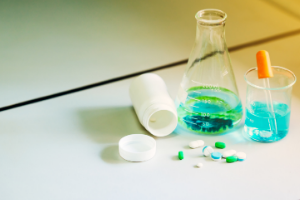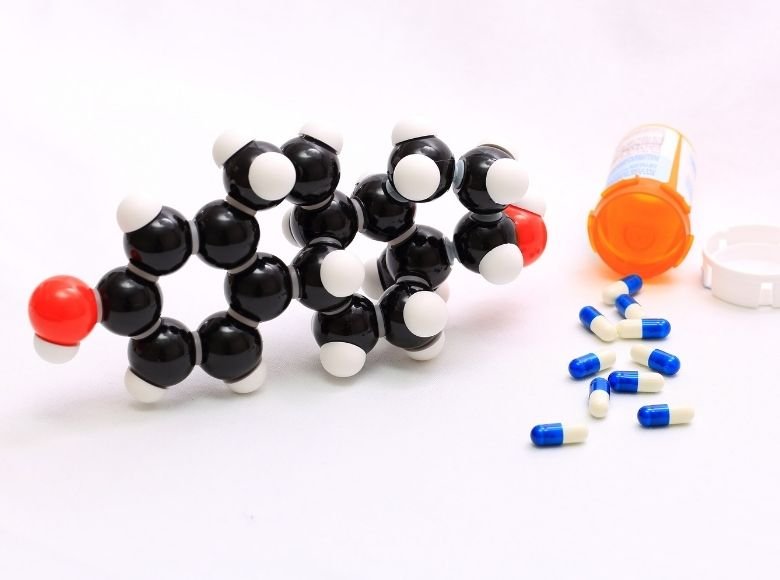Medicines have been used for millennia. The journey to the development of pharmaceutical substances currently available on pharmacy shelves was not easy and required hundreds of years of research. Currently, on the global pharmaceutical market, we can find a wide range of drugs that allow the preparation to be tailored to the individual needs of the consumer.
The science that focusses on pharmacologically active compounds is called drug chemistry.

What is drug chemistry?
Its beginning is considered to be the first isolation of a chemically homogeneous drug substance from plant material by Friedrich Sertürner. This discipline deals with the study of the structure of drugs, their physicochemical properties, methods of preparation including synthesis, effects on the human body, as well as qualitative and quantitative chemical evaluation.
An important aspect related to medicinal substances is conducting research on the stability of drugs, i.e. resistance to physicochemical and biological factors. Enzymes, environmental pH as well as light and temperature are all factors that can induce changes in the structure or properties of drugs. This may increase the toxicity of the preparations, as well as affect the pharmacological activity, which is weakened or completely lost. For this reason, the qualitative and quantitative analysis is an important element of the research on medicinal substances, the results of which are compared to strictly defined standards for a given drug and its forms.

Qualitative analysis, i.e. learning the chemical composition
The main components of pharmaceuticals are active substances, most of which are classified as organic compounds. Before starting a qualitative analysis, their physical properties such as colour, odour and physical state should be determined. Then, a combustion analysis is performed, thanks to which the organic nature of the tested compound can be confirmed. The basic methods of preliminary qualitative analysis also include the solubility test, which allows the hydrophilic properties of active substances and their acid-base character to be determined.
An important element of the research is the elementary qualitative analysis. It is a transformation of an organic compound into ionic bonds by melting it with excess sodium. In this way, it is possible to detect the presence of individual elements in the active ingredient. To perform these tests, specific chemical reagents are needed, which are used depending on the type of test we are carrying out.
- Nitrogen test – saturated solution of iron (II) sulphate, diluted sulfuric acid
- Sulphur test – acetic acid and lead (II) acetate or sodium nitroprusside
- Halogens test – diluted nitric acid and an aqueous solution of silver nitrate
Quantitative analysis, i.e. discovering the numerical value of the chemical composition
Its task is to determine the quantitative composition of substances – the content or concentration of individual components. In order to carry out the quantitative analysis of organic compounds, the following methods can be used:
- Acid-base volumetric analyses – performed by titration with standard solutions of acids or bases. In the case of titration in a non-aqueous medium, the following solvents are used: acetone, nitromethane, formic acid, acetic acid, alcohols or hydrocarbons.
- Redoximetric analyses – can be divided into oxidimetry (titration with standard solutions of oxidants, e.g. KMnO4) and reductometry (titration with standard solutions of reducing agents, e.g. FeSO4 solution).
- Iodometric analyses – titration is performed with standard iodine solution (determination of reducing agents) or thiosulphate (determination of oxidants).
- Precipitation analyses – an insoluble precipitate is formed during titration. The most frequently used technique of precipitation analysis is argantometry, which produces sparingly soluble silver compounds, e.g. AgCl or AgBr.

PCC Group offer
The PCC Group Product Portal offers pharmaceutical raw materials of the highest quality, using production standards compliant with the International Organization for Standardization ISO, GMP (Good Manufacturing Practice) standards and the requirements of the latest version of the European Pharmacopoeia.
There are three main groups of raw materials used in the production of drugs: active pharmaceutical ingredients, auxiliaries and fillers, which are responsible for giving the final form of the drug.
PCC Group offers raw materials from each of these categories. The reagents that are used during the synthesis of API (Active Pharmaceutical Ingredients) include, among others, monochlorobenzene and orthodichlorobenzene. Hydrochloric acid – check where to buy hydrochloric acid – or sodium hydroxide (caustic soda manufacturers), which can also be found in our offer, are also used as process solvents or pH regulators. Hydrochloric acid used in the pharmaceutical industry is of a high purity – at the level of 37%, and is used in the synthesis of drugs such as ascorbic acid and para-aminobenzoic acid.
As auxiliary substances, you can use the POLIkol series products of pharmaceutical quality, which belong to the group of polyoxyethylene glycols, and the products of the ROKAnol series. Rokacet HR40Pf and Rokacet R36PF also deserve special attention, as they are very good emulsifiers of active substances that are difficult to dissolve in water. They are perfect as emulsifiers of vitamins in multivitamin preparations. The offer also includes polysorbates. Polysorbate 20 and Polysorbate 80 are products also used as solubilisers of active substances. The range of POLIkol products includes chemical compounds such as PEGs – polyethylene glycols. They comply with the strict quality requirements of the European Pharmacopoeia, thanks to which they are part of modern drugs in the form of soft capsules, suppositories, pessaries, tablets, and can also be used as a base for ointments.
PCC Group is a producer of pharmaceutical raw materials, supplying its products to the largest pharmaceutical companies not only in Poland, but also around the world. Thanks to the wide range of products offered, it is possible to obtain in one place the raw materials needed for the synthesis of drugs, as well as the substances necessary for qualitative and quantitative analyses.
- Zając. M., Jelińska A., I. Muszalska: Chemia leków z elementami chemii medycznej, Wydawnictwo Naukowe Uniwersytetu Medycznego im. Karola Marcinkowskiego w Poznaniu, Poznań 2018
- Ocena jakości substancji i produktów leczniczych, pod red. M. Zając i A. Jelińskiej, Wydawnictwo Naukowe Uniwersytetu Medycznego im. Karola Marcinkowskiego w Poznaniu, Poznań 2010
- Witaminy i mikroelementy, red. M. Zając, Kontekst 2000
- Steinhilber D., Schubert-Zsilavecz M., Roth H.J. Chemia medyczna, redakcja wydania polskiego Jelińska A., Pałka J. Zając M., MedPharm Polska, Wrocław, 2012
